Upper Limb Tension Tests (ULTTs)
Original Editor - Jennifer Self
Top Contributors - Kim Jackson, Admin, Adrianna Simmons, Jennifer Self, Hetvi Gala, Evan Thomas, Aminat Abolade, Cindy John-Chu, Jeannine Escobar, Johnathan Fahrner, WikiSysop, Claire Knott and Lucinda hampton
Introduction[edit | edit source]
The Brachial Plexus Tension or Elvey Test, also known as Upper Limb Tension Tests,[1] are designed to put stress on neurological structures of upper limb. These tests were first described by Elvey[2] and hence also known as Elvey test but most commonly called ULTT. The ULTT's are equivalent to the straight leg raise designed for the lumbar spine.
Purpose[edit | edit source]
- To test for the presence of cervical radiculopathy
- A component of the Test Item Cluster for the Diagnosis of Cervical Radiculopathy to determine the likelihood that a patient has cervical radiculopathy
Technique[3][edit | edit source]
The patient is supine. The examiner performs the following movement sequence:
- Scapular depression
- Shoulder abduction
- Forearm supination, wrist and finger extension
- Shoulder lateral elevation
- Elbow extension
- Contralateral/ipsilateral cervical side bending
Positive Test
The test is positive if one or more of the following occurs:
- Symptoms reproduced
- Side to side difference in elbow extension greater than 10 degrees
- Contralateral cervical side bending increases symptoms, or ipsilateral side bending decreases symptoms
Evidence[edit | edit source]
Diagnostic Accuracy[5]
Reference standard cervical radiculopathy as diagnosed by needle electromyography and nerve conduction studies.
Sensitivity= .50
Specificity= .86
-LR= .58
+LR= 3.5
Reliability
Inter-examiner Kappa= .76
Resources[edit | edit source]
For more information visit this Physiopedia page Neurodynamic Assessment
References[edit | edit source]
- ↑ Magee DJ.Orthopaedic physical assessment.5th edition.Elsevier publication.
- ↑ Elvey RL: The investigation of arm pain. In Boyling JD, Palastanga N (eds): Grieve’s modern manual therapy: the vertebral column, 2nd ed. Edinburgh, 1994, Churchill Livingstone.
- ↑ Flynn TW, Cleland JA, Whitman JM. Users' Guide To The Musculoskeletal Examination. Evidence in Motion; 2008.
- ↑ ULTT Median Nerve Bias. (2009, June 8). ClinicallyRelevant.com: Upper Limb Tension Test A [Video]. Retrieved Nov 15, 2009, from http://www.youtube.com/watch?v=dlGVm4uKCMY
- ↑ Hartley A. Practical Joint Assessment. St Louis: Mosby; 1995.







